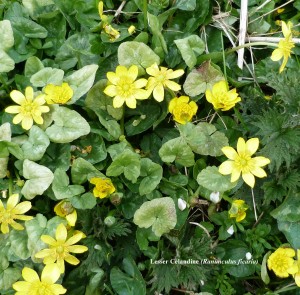Lesser Celandine
Latin: Ranunculus ficaria
Irish: Grán arcáin
This native species resembles its close relative the Buttercup. It is from the same genus (Ranunculus) and is often mistaken for Buttercup but it is a different, and distinct, species. It has a number of features that allows it to be distinguished from buttercup, especially the shape and structure of its leaves and flowers.
The leaves of Buttercup are deeply divided into distinct lobes while those of Lesser Celandine are heart-shaped or round and they are not divided into lobes.
Ranunculus ficaria flowers from March to June and can be seen in many, more or less undisturbed, parts of the course, e.g. in many parts of the rough, in the motte-and-bailey at the 10th green and along the avenue.
It is a very striking feature of the course during March/April when there are few other bright flowers to distract the eye.
The flowers of Buttercup and Lesser Celandine are both bright, shining yellow, they are about the same size (15-30mm across), they open in spring sunshine and often appear in large numbers. However, Buttercup flowers have 5 petals and Lesser Celandine flowers have 8-10 petals that are narrower than those of Buttercup.
Some types of Lesser Celandine produce small white tubers in the axils of the leaves after flowering and it is these that led to a particular medicinal use. The tubers are said to resemble piles (haemorrhoids) and under the “Doctrine of Signatures” this led to them being used as a treatment for piles and also accounts for one of the alternative common names for this species – Pilewort.